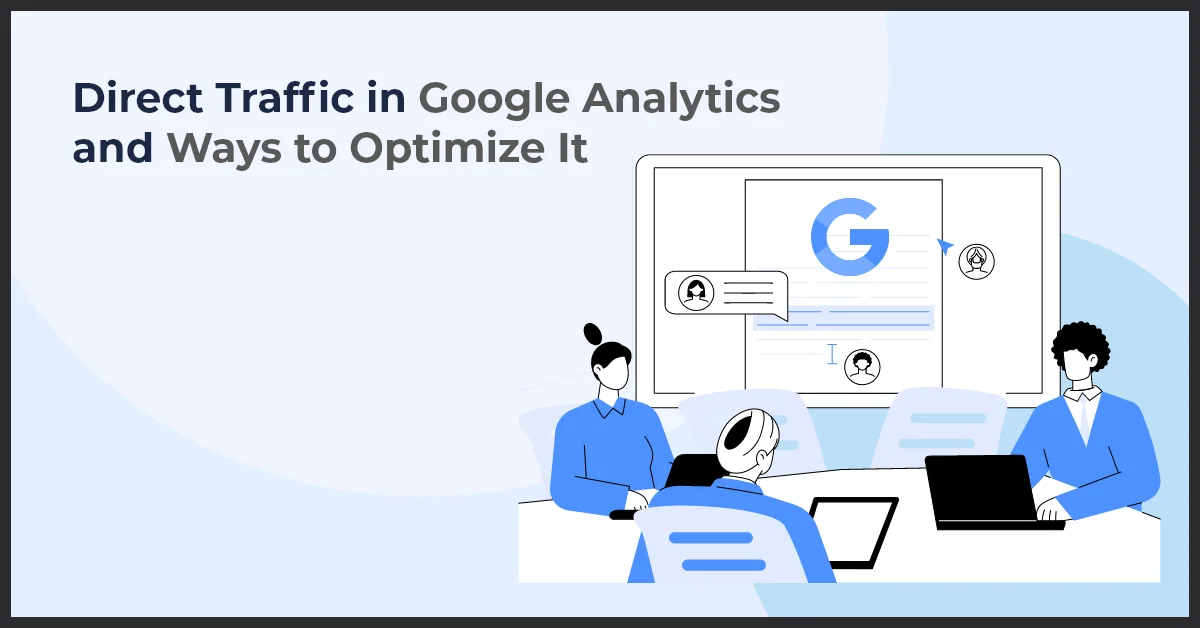Direct Traffic in Google Analytics and Ways to Optimize It

Published on: June 10, 2024
Updated on: July 11, 2024
583 Views
- Analytics
11 min read
Direct traffic in Google Analytics can sometimes be misleading. It sounds like something forthright that helps marketers see how users engage with their web content. But that’s not what it is at all.
Google Analytics and similar tools, including Adobe Analytics, lack in-depth insights into visitor-level analytics. While these tools can show you overall website traffic, they fall short of tracking direct traffic comprehensively.
But what exactly is direct traffic? What are the reasons leading to direct traffic to your website? Is it something that impacts your marketing strategy? More importantly, how can you overcome it to better understand where your users are coming from?
Keep reading to get all your answers.
Introduction to Direct Traffic in Google Analytics
In Google Analytics, 'direct traffic' refers to cases where we can't identify where the website visit is coming from or accurately track the referring source. This usually includes visitors who land on your site by typing the URL directly into their web browser. Essentially, these are visitors who navigate to your site without the aid of search engines, social media, or other external links.
However, direct traffic also includes visits that can't be linked to a specific source. For example, when someone clicks a link in a Facebook ad lacking tracking parameters, it's categorized as direct traffic.
Direct traffic could suggest either strong brand recognition or, conversely, insufficient tracking mechanisms. Determining the cause is crucial, and we're here to assist in making that process more straightforward.
Understanding the Sources of Direct Traffic
Understanding direct traffic in Google Analytics involves recognizing its various causes.
Let's explore the factors that can lead to direct traffic:
1. Autofill, Manual Address Entry, or Bookmarks
When a user accesses your site through an organic search and then revisits it a week later via a direct method, both visits are typically attributed to organic search, according to Google's set lookback period.
The prevalent causes for direct traffic in Google Analytics include autofill, manual URL entry, or bookmarks. In Google Analytics 4, these factors are inherently unavoidable.
For example, a user initially finds your website through an organic search. If they revisit your site later, perhaps a week later, and begin typing your website’s name in the search bar, their device may complete the entry using cookies and cache data. This results in a direct visit. The same applies if the user manually types your website address or uses a bookmark, especially when switching devices.
2. Missing or Broken Tracking Code
Missing or malfunctioning tracking codes are another typical source of direct traffic. When developing your site or adding new templates, it’s vital to include the Google Analytics code on each page. If a page is missing this code, Google Analytics can't identify the user's source, leading to sessions being marked as direct.
For example, your marketing team creates a new landing page for a promotional campaign. This page is designed to attract users from various online ads and emails. During the setup, the team forgets to include the tracking code on this new landing page. A user clicks on an ad link that directs them to this new landing page.
Since the landing page lacks the GA4 tracking code, Google Analytics does not receive any data about where this traffic came from. The user then clicks on a link within the landing page, which takes them to another part of your website – one that has the GA4 code correctly implemented.
When the user reaches the second page, GA4 starts tracking their interaction. However, since GA4 didn't capture the user’s entry point (the landing page without the tracking code), it is unable to determine the source of the traffic. As a result, this visit is categorized as 'direct traffic.' Below is how to differentiate between direct and other traffic sources in Google Analytics:
- Non-web Documents
For links in non-web documents like Word, Google Docs, or Acrobat Reader, referrer information is not passed on. As a result, visits from these links are generally categorized as direct. To mitigate this, you can use UTM parameters in your links, allowing Google Analytics to capture referral data from these otherwise untrackable sources.
- HTTP to HTTPS
Regarding HTTP and HTTPS transitions, if a user clicks a link from a secure (HTTPS) site that leads to a non-secure (HTTP) site, no referrer data is transmitted. Such sessions are classified as direct traffic. This is an inherent feature of secure protocols. A noticeable increase in direct traffic at the expense of referral traffic might indicate a key referrer's switch to HTTPS.
- Dark Social
Finally, 'dark social' refers to unattributable social shares, like links passed through Facebook Messenger, WhatsApp, email, or Skype. A significant portion of link sharing occurs through these channels, complicating attribution for marketers. Dark social can be likened to an online version of word-of-mouth marketing – elusive yet potentially rewarding. Given its rising prevalence, incorporating self-reported attribution could be beneficial in assessing the impact of dark social.
Analyzing Direct Traffic Data
To analyze direct traffic concerning other channels in Google Analytics 4 (GA4), follow these more detailed steps:
- Start by logging in to your GA4 account.
- Click on the 'Reports' section.
- Within this section, locate and select the 'Traffic Acquisition' option, which falls under the 'Lifecycle' category.
- Once you're in the Traffic Acquisition report, you'll see various metrics and data visualizations that represent different aspects of your website's traffic.
- Take some time to explore the interface. You'll find data on various traffic sources and how they compare to one another.
- Scroll through the report to specifically locate data concerning your direct traffic.
This process will allow you to compare direct traffic figures with other channels like organic search, social media, referrals, etc.
Applying Comparisons and Viewing Options:
GA4 offers you the flexibility to view direct traffic data through different lenses. You can compare it based on:
- The landing page where users first arrived at.
- The first source that brought the user to your website.
- The session medium categorizes the type of traffic (like organic, referral, direct).
These comparisons can be applied using the comparison tool in the report for more targeted analysis. For a more granular and customized analysis, use the Exploration feature in GA4. Exploration allows you to create custom reports using templates. These custom reports can offer deeper insights into your direct traffic, revealing patterns and trends that might not be immediately apparent.
Adding Filters and Segments:
To gain even more detailed insights, consider adding filters and segments to your reports.
Filters can narrow down the data to specific criteria, such as geographic location, device type, or user behavior.
Segments allow you to isolate and analyze specific subsets of your traffic data. For example, you might want to look specifically at users who visited a particular section of your site and came through direct traffic.
By using these tools and features in GA4, you can not only view your direct traffic data but also dissect it to understand the underlying factors driving this traffic.
This in-depth analysis can reveal valuable insights, like user behavior patterns, the effectiveness of your website's layout in retaining direct traffic, and potential areas for improvement in your overall digital strategy.
The key to leveraging GA4 effectively is to experiment with its various features and tools to uncover the most relevant and actionable insights for your website’s traffic and performance.
Optimizing Your Website for Direct Traffic
Direct traffic, while unavoidable, is not inherently negative. It often signifies that your website is well-known and actively sought after by users. A healthy range for direct traffic in Google Analytics is typically between 5% and 20%. However, if it exceeds this range, it may suggest inaccuracies in data collection, prompting a need for corrective measures to gain clearer insights into your marketing strategies. Consider the following strategies to effectively manage direct traffic in Google Analytics:
- Implement UTM Parameters: Essential for marketers, UTM parameters involve tagging URLs with specific tracking codes (known as UTM tracking codes) for campaign tracking. This practice allows for detailed insights into user navigation of your site and the performance of your campaigns.
- Set Up First-Party Attribution Tracking: Addressing direct traffic issues is not just about technical adjustments; marketing attribution plays a crucial role. It enables a comprehensive view of a user's journey, going beyond the last session to encompass the entire experience.
- Use Attribution with Marketing Mix Modeling (MMM): Incorporating MMM in your strategy can refine your understanding of marketing impacts.
- Migrate to HTTPS: Ensuring a secure connection can improve tracking accuracy.
- Avoid Vanity URLs: These can complicate tracking efforts.
- Check Your Google Analytics Code: Regular audits can ensure accurate data collection.
- Block Internal Traffic: This helps in filtering out in-house interactions that might skew your data.
- Utilize Marketing Mix Modeling: This approach offers a comprehensive analysis of marketing efforts.
For a practical understanding, consider using tools like Ruler for a detailed examination of marketing attribution. This involves tracking the full journey of users, from their initial interaction to the final session, thus offering a holistic view of direct traffic and its implications.
Leveraging Social Media and Email Marketing
Google Analytics not only offers an overview of the traffic sources to your site or blog but also includes traffic from social media. This report allows you to easily compare the impact of social media with other channels.
- To access this report in Google Analytics, navigate to Acquisition > All Traffic > Channels. You can also analyze traffic from specific social media networks by going to Acquisition > Social > Network Referrals.
Creating social media posts with links to your site enables Google Analytics to track, sort, and analyze this traffic. By combining these links with UTM tracking and goals, you gain insights into social media's effect on revenue. You can set unique UTMs for all your social media activities, per channel, or even per update, depending on your level of detail preference.
First, set up UTM parameters on all your social media links, then assign a dollar value to a conversion goal in Google Analytics.
Setting Up UTM Parameters on Your Links:
- Begin by visiting Google's URL Builder.
- Set the Source parameter to indicate your posts originate from social media.
- Then, use the Medium parameter to specify the social media network (Facebook, Twitter, Pinterest, etc.) where you publish your post.
- Lastly, employ the Campaign parameter to create a unique identifier for each social media post you wish to track.
Implementing Referral Tracking for Dark Social
Dark social dominates the social sharing space. When you copy and paste a URL into an email and send it to a friend, you're contributing to dark social. Astonishingly, 84% of consumers’ outbound sharing occurs through dark social channels like instant messaging and email, which represent the majority of your customers and potential customers. And the real surprise? You probably don't even know it's happening! This means a mere 16% of sharing occurs on visible social platforms.
So, to connect with the invisible audience silently advocating for your brand, it’s crucial to focus on dark social in your marketing strategy. Now you understand dark social and its importance, let's explore how to tackle it.
- First, create share-worthy content. Without compelling content, there's nothing to track.
- Next, start tracking dark social by using shortened URL links. Tools like Bit.ly, TinyURL.com, and Goo.gl create unique, trackable links. These links can be shared on social networks, emails, and your website. The websites for creating these links are user-friendly, often offering free services.
- Also, optimize your content for mobile consumption and sharing. Most content sharing and online communication happen on mobile devices, with 62% of clickbacks from dark social shares coming from mobile, compared to 38% on desktop. As of 2015 and 2016, mobile searches and traffic rivaled desktop.
- Finally, consider using Dark Social tools. Tools like GetSocial.io, AddThis, and ShareThis track copy-and-pasted shares in dark social channels by adding trackable codes or installing codes onto a site. Implementing these tools requires more effort but is essential for a robust dark social tracking strategy.
Conclusion
By now, you know the causes leading to direct traffic to your website, and how you can analyze your direct traffic data in Google Analytics 4. All in all, minimizing direct traffic to your website is important because it can indicate a lack of effective marketing or branding. It means users are not reaching your site through search engines, referrals, or campaigns, which can provide valuable insights and engagement opportunities. So, dive into the insights, optimize your strategies, and make every visitor's journey intentional.
Ready to Navigate the Intricacies of Direct Traffic? Let’s Talk!
The experts at Growth Natives would love to pitch in. Drop us an email at info@growthnatives.com, and we will reach out to you.
Frequently Asked Questions
Direct traffic is important to track because it represents a significant portion of website visits and can provide insights into brand awareness, offline marketing effectiveness, and user behavior. Understanding direct traffic helps marketers gauge the effectiveness of their branding and offline advertising efforts.
Common reasons for an increase in direct traffic include:
Brand recognition and direct visits from users who are familiar with your brand.
Typing errors or incomplete URLs entered directly into the browser.
Visitors accessing your website from untracked sources, such as PDFs, emails, or instant messaging apps.
Changes in tracking settings or implementation errors that result in misattribution of traffic.
Direct traffic is often considered the default or “last-touch” channel in multi-channel attribution modeling. While it may not directly contribute to conversions in the same way as other channels, it can still play a crucial role in the customer journey by indicating brand awareness and consideration.
Yes, you can segment direct traffic in Google Analytics by various dimensions, including geographic location, demographics, and user behavior. This allows you to analyze direct traffic patterns and behaviors for specific audience segments and tailor your marketing strategies accordingly.



